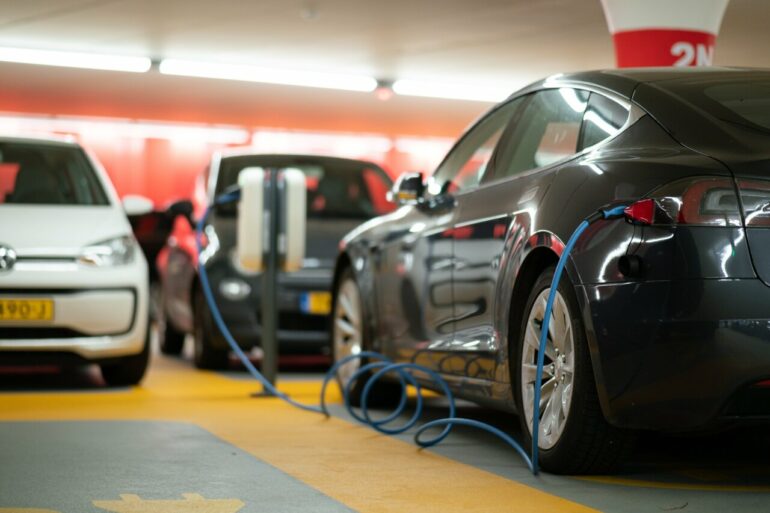A new study from the University of Toronto’s Department of Civil & Mineral Engineering suggests that large-scale adoption of electric vehicles (EVs) could lead to significant population-level health benefits.
The research team used computer simulations to show that aggressive electrification of the U.S. vehicle fleet, coupled with an ambitious rollout of renewable electricity generation, could result in health benefits worth between US$84 billion and 188 billion by 2050.
Even scenarios with less aggressive grid decarbonization mostly predicted health benefits running into the tens of billions of dollars.
“When researchers examine the impacts of EVs, they typically focus on climate change in the form of mitigating CO2 emissions,” says Professor Marianne Hatzopoulou, one of the co-authors of the study, which is publishedin the Proceedings of the National Academy of Sciences.
“But CO2 is not the only thing that comes out of the tailpipe of an internal combustion vehicle. They produce many air pollutants that have a significant, quantifiable impact on public health. Furthermore, evidence shows that those impacts are disproportionately felt by populations that are low-income, racialized or marginalized.”
Other members of the team include lead author and postdoctoral fellow Jean Schmitt, Professors Daniel Posen and Heather Maclean, and Amir F.N. Abdul-Manan of Saudi Aramco’s Strategic Transport Analysis Team.
Members of this team had previously used their expertise in life-cycle assessment to build computer models that simulated the impact of large-scale EV adoption in the U.S. market.
Among other things, they showed that while EV adoption will have a positive impact on climate change, it is not sufficient on its own to meet the Paris Agreement targets. They recommended that EV adoption be used in combination with other strategies, such as investments in public transit, active transportation and higher housing density.
In their latest study, the team wanted to account for the non-climate benefits of EV adoption. They adapted their models to simulate the production of air pollutants that are common in fossil fuel combustion, such as nitrogen oxides, sulfur oxides and small particles known as PM2.5.
“Modeling these pollutants is very different from modeling CO2, which lasts for decades and ends up well-mixed throughout the atmosphere,” says Posen. “In contrast, these pollutants and their associated health impacts are more localized. It matters not only how much we are emitting, but also where we emit them.”
While EVs do not produce any tailpipe emissions, they can still be responsible for air pollution if the power plants that supply them run on fossil fuels such as natural gas or coal. This also has the effect of displacing air pollution from busy highways to the communities that live near those power plants.
Another complication is that neither the air pollution from the power grid nor that from internal combustion vehicles is expected to stay constant over time.
“Today’s gasoline-powered cars produce a lot less pollution than those that were built 20 years ago, many of which are still on the road,” says Schmitt.
“So, if we want to fairly compare EVs to internal combustion vehicles, we have to account for the fact that air pollution will still go down as these older vehicles get replaced. We can also see that the power grid is getting greener over time, as more renewable generation gets installed.”
In the model, the team chose two main scenarios to simulate out to the year 2050. In the first, they assumed that no more EVs would be built, but that older internal combustion vehicles would continue to be replaced with newer, more efficient ones.
In the second, they assumed that by 2035, all new vehicles sold will be electric. The researchers described this as “aggressive,” but it is in line with the stated intentions of many countries. For example, Norway plans to eliminate sales of non-electric vehicles next year, and Canada plans to follow suit by 2035.
For each of these scenarios, they also considered various rates for the transition of the electric grid to low-emitting and renewable energy sources, i.e., whether it stays roughly the same as the current rate, slows down, or accelerates over the next couple of decades.
Under each of these sets of conditions, the team simulated levels of air pollution across the United States. They then used established calculations commonly used by epidemiologists, actuaries and government policy analysts to correlate these pollution levels with statistical estimates of the number of years of life lost, as well as with estimates of economic value.
“Our simulation shows that the cumulative public health benefits of large-scale EV adoption between now and 2050 could run into the hundreds of billions of dollars,” says Posen.
“That’s significant, but another thing we found is that we only get these benefits if the grid continues to get greener. We are already transitioning away from fossil fuel power generation, and it’s likely to continue in the future. But for the sake of argument, we modeled what would happen if we artificially freeze the grid in its current state. In that case, we’d actually be better off simply replacing our old internal combustion vehicles with new ones—but again, this is not a very realistic scenario.”
This finding raises another question: is it more important to decarbonize the transportation sector through EV adoption, or to first decarbonize the power generation sector, which is the ultimate source of pollution associated with EVs?
“To that I would say that it’s important to remember that the vehicles being sold today will continue to be used for decades,” says Hatzopoulou. “If we buy more internal combustion vehicles now, however efficient they may be, we will be locking ourselves into those tailpipe emissions for years to come, and they will spread that pollution everywhere there are roads.
“We still need to decarbonize the power generation system—and we are—but we should not wait until that process is complete to get more EVs on the road. We need to start on the path to a healthier future today.”
More information:
Jean Schmitt et al, Health benefits of US light-duty vehicle electrification: Roles of fleet dynamics, clean electricity, and policy timing, Proceedings of the National Academy of Sciences (2024). DOI: 10.1073/pnas.2320858121
Provided by
University of Toronto
Citation:
New research reveals how large-scale adoption of electric vehicles can improve air quality and human health (2024, October 15)



